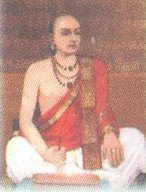Andhra Mahabharatam
This article needs additional citations for verification. (October 2021) |
| Andhra Mahabharatham ఆంధ్ర మహాభారతం | |
|---|---|
 | |
| Information | |
| Religion | Hinduism |
| Author | Nannayya Thikkana Yerrana |
| Language | Telugu |
| Chapters | 18 Parvas |
| Verses | 21,507 Poems |
Andhra Mahabharatham ఆంధ్ర మహాభారతం is the Telugu version of Mahabharatha written by the Kavitrayam (Trinity of poets), consisting of Nannayya, Thikkana and Yerrapragada (also known as Errana).The three poets translated the Mahabharata from Sanskrit into Telugu over the period of the 11–14th centuries CE, and became the idols for all the following poets.[1] More than calling "Andhra Mahabharatham" as a translation of Sanskrit Mahabharatha written by Lord Ganesha under the supervision of Veda Vyasa, this Andhra Mahabharatham was an independent translation. Thus, this translation is not a stanza by stanza translation. These three poets wrote Andhra Mahabharatham in Telugu literature style, but keeping the same exact essence as that of Sanskrit Mahabharatham



- Adikavyam in Telugu
There are many doubts about whether Mahabharata is the first work of poetry started by

Rajaraja Narendra (1019–1061 AD)
Kavithrayam at work
| Parvam | Number of subparvas | Number of Shlokas in Sanskrit Mahabharatham |
Number of Shlokas in Andhra Mahabharatham | Verse Prose no |
|---|---|---|---|---|
| 1. Adi Parvam | 18 | 9,984 | 8 | 2,084 |
| 2. Sabha Parvam | 9 | 4,311 | 2 | 618 |
| 3. Aranya Parvam
|
16 | 13,664 | 7 | 2,894 |
| 4. Virata Parvam | 4 | 3,500 | 5 | 1,624 |
| 5. Udyoga Parvam | 11 | 6,998 | 4 | 1,562 |
| 6. Bhishma Parvam | 5 | 5,884 | 3 | 1,171 |
| 7. Drona Parvam | 8 | 10,919 | 5 | 1,860 |
| 8. Karna Parvam | 1 | 4,900 | 3 | 1,124 |
| 9. Salya Parvam | 4 | 3,220 | 2 | 827 |
| 10. Sauptika Parvam | 3 | 2,874 | 2 | 376 |
| 11. Stri Parvam | 5 | 1,775 | 2 | 376 |
| 12.Shanti Parvam | 4 | 14,525 | 6 | 3,093 |
| 13. Anushasanika Parvam | 2 | 12,000 | 5 | 2,148 |
| 14. Ashwamedha Parvam | 2 | 4,420 | 4 | 976 |
| 15. Ashramavasa Parvam | 3 | 1,106 | 2 | 362 |
| 16. Mausala Parvam | 1 | 300 | 1 | 226 |
| 17.Mahaprasthanika Parvam | 1 | 120 | 1 | 79 |
| 18. Svargarohana Parvam | 1 | 200 | 1 | 97 |
| 19. Harivamsa Parvam|Bhavishya Parvam
|
2 | (Omitted) | -- | -- |
| Total | 100 | 1,00,500 | 63 | 21,507 |
Nannaya — the Adi Kavi (the first poet)

Nannayabhatta (1022–1063 CE – also referred to as Nannaya), started to translate the Sanskrit Mahabharata into Telugu on the request of the East Chalukya king Rajaraja Narendra. This marks the beginning of Telugu literature, which has yet been uncovered. This work has been interpreted in the Champu style and emotes such simplicity and polishing and of such high literary excellence, that several scholars do not dismiss the possibility of the existence of literary works in Telugu during the pre-Nannaya period.
Tikkana
Tikkana (or Tikkana Somayaji) (1205–1288) was a 13th century
Yerrana
Yarrapragada Erranna was a
Nrusimhapuranamu was his own independent work.[5] Erranna received his inspiration for the Nrusimhapuranam from his grandfather Errapotanna. According to tradition, one day when Erranna was meditating, his grandfather appeared and advised him to write the Narisimhapuranamu. This work was based on the Brahmandapuranamu and the Vishnupuranamu.
According to the Viṣṇu Purāṇa, King Hiraṇyakaśipu was the powerful demonic sovereign of the Earth millions of year ago at the beginning of the
See also
External links
References
- ^ "Telugu Literature | Telugu Basha". Archived from the original on 28 March 2014. Retrieved 27 March 2014.
- ^ History of Telugu literature - Author: Dwa.Na. Shastri - Publication : Pratibha Publications, Hyderabad (2004)
- ^ "Vaishanava yugamu" (PDF). Archived from the original (PDF) on 4 March 2009. Retrieved 17 August 2022.
- ^ Errapragada (1926). Harivamsamu (in Telugu). Madras: Vavilla Ramaswamy Sastrulu and Sons. Retrieved 16 June 2020.
- ^ Errapragada (1960). Nrisimhapuranamu (in Telugu). Madras: Vavilla Ramaswamy Sastrulu and Sons. Retrieved 16 June 2020.
